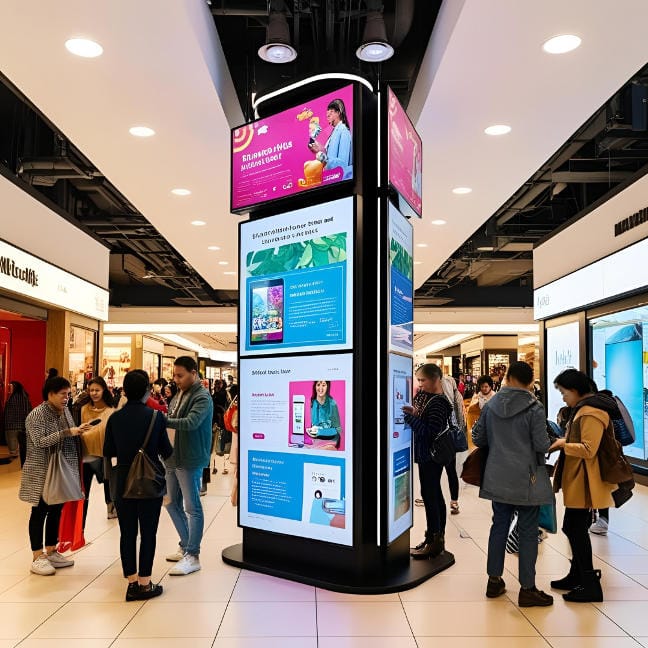In an age where almost everything is digitalized, businesses always look for new and effective ways to capture attention and deliver dynamic content. One such solution, which has seen massive adoption, is white-label digital signage. This powerful tool becomes a versatile and customized platform organizations use to increase brand exposure, streamline communication, and boost customer experience. This article discusses what white-label digital signage is, its benefits, its applications, and how it would revolutionize how businesses interact with their audiences.
Understanding White Label Digital Signage
White-label digital signage is an advanced tool that allows a third-party vendor to customize it, rebrand it, and resell it in its entirety by businesses as a solution. Traditional digital signage comes with the provider’s branding on the software and hardware, whereas white-label solutions offer a blank canvas for matching the company brand identity.
This flexibility allows businesses to fit digital signage into their existing marketing strategies smoothly, thereby fostering a coherent brand experience across all touchpoints. White-label digital signage provides a cross-market platform that includes retail stores, corporate offices, restaurants, and public areas, among others, to deploy engaging content and real-time information.

Key Benefits of White Label Digital Signage
- Brand Consistency: This probably stands as one of the most significant benefits of white-label digital signage: the interface allows business owners to personalize the display elements, including logos, color schemes, and general design, to represent their brand correctly. That way, every tiny bit of information displayed would carry the company’s identity and its message.
- Cost-Effective Solution: Building an in-house digital signage system can be time- and money-consuming. White-label solutions do away with the need for much research, development, and maintenance; hence, businesses can leverage ready platforms at a fraction of the cost. Therefore, this cost factor makes digital signage accessible to companies of all sizes.
- Scalability: White-label digital signage solutions are designed to be highly scalable so that whenever your business needs more displays added to its network, scalability is easy. Whether you need one display or hundreds at several locations, white-label solutions make it easier for such a growing requirement without losing performance and quality.
- Streamlined Content Management: Proper content management is necessary for any digital signage system. White-label solutions come with easy-to-use content management systems that enable the business to create, schedule, and update content seamlessly. This way, the right message can be pushed to the right audience at the right time.
- Enhanced Customer Engagement: Simply put, digital signage is one of the most attractive tools, especially for customers. With these, businesses can incorporate dynamism and interactivity into white-label solutions that could, in turn, be appealing to the customer base. These could include anything from promotional videos and social media feeds to live news updates and interactive wayfinding.
- Real-Time Updates: Another feature that stands out with digital signage is its ability for real-time updates. White-label solutions empower businesses to enable the facility to update content on the spot, maintaining that necessary level of actuality and relevance to whoever is reading the advertising material. This becomes particularly useful for retail, where promotions and product availability rapidly change.
Applications of White Label Digital Signage
- Retail: White label digital signage in the retail sector can be put to use to change shopping. Digital displays can feature product promotion, focusing on offers, and even give wayfinding help to the customers. Interactive kiosks should provide the customer a chance to go through inventory check prices, and order items. This does not only serve to improve the experience customers have but can help boost sales and increase dwell time.
- Corporate Communication: In this big corporate world, white-label digital signage is a handy tool for internal corporate communication. It helps in putting across company announcements, essential KPIs, and information about the various employee engagement activities within the office lobbies, break rooms, and conference areas. This ensures the presence of a connected and informed workforce.
- Hospitality: Digital signage steps up guest experience in the hospitality sector. In hotels and resorts, digital displays can be used for wayfinding, event schedules, and local attractions. In restaurants, they can have their menu displayed, their specials of the day, and even some customer reviews. Timely and relevant information makes people happy and loyal guests.
- Education: Schools may improve the way they communicate with students and teachers, as well as with visitors, by using white-label digital signage. Digital displays offer access to campus maps, event notifications, emergency alerts, and general vital announcements, leading to a much safer and informed campus environment.
- Healthcare: Enhancing the patient experience and making healthcare services more effective, digital signage in healthcare institutes hastens the work process with fewer errors. Digital signages at hospitals and clinics are being used for appointment reminders, health education, wayfinding, and waiting room entertainment to decrease perceived wait times and increase patient satisfaction.
- Public Spaces: White label digital signage is ideal for use at airports, train stations, and shopping malls. Real-time travel information, advertisements, and emergency alerts are part of what digital displays can provide. It ensures a visitor is informed and knows how to navigate the space.

Choosing the Right White Label Digital Signage Solution
When selecting a white label digital signage solution, businesses should consider several key factors:
- Customization Options: The solution must have vast customization features for a brand to meet its identity. Look out for elements like customized templates, branding, and design flexibility.
- Ease of Use: The content management system should be very easy to use so that your staff can easily create, schedule, and update content with ease. Training and support resources are also important to consider.
- Scalability: Consider a solution that will scale up your business. Whether you’re starting with one display or possibly expanding to many venues, the platform should allow for future growth.
- Integration Capabilities: Judge how effectively your solution will mesh with existing systems and software. Seamless integration will ensure smooth implementation procedures and the utmost general effectiveness.
- Reliability and Support: Look for a reputable provider with a track record of reliability and excellent customer support. There might be some technical issues, and in this case, a supportive team steps in to play its responsive part.
Conclusion
White Label Digital Signage has revolutionized how businesses can increase brand visibility, ease communication, and boost customer interaction. It gives companies a cost-effective, scalable, and custom way of real-time information delivery with dynamic content, hence providing up-to-date information in a field that is always in a state of change, with a myriad of applications across retail, corporate, hospitality, education, health, and public spaces. Embracing this technology can revolutionize how businesses interact with their audiences, creating memorable and engaging experiences that drive success in today’s digital age.




